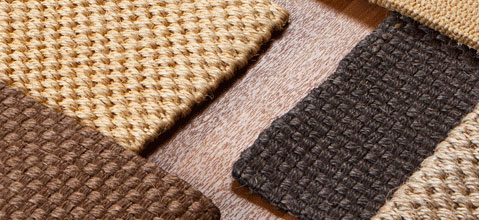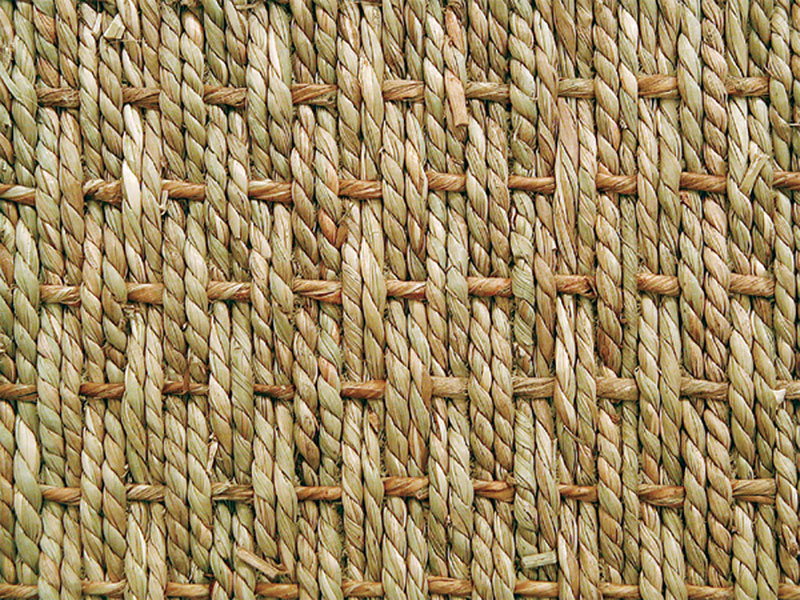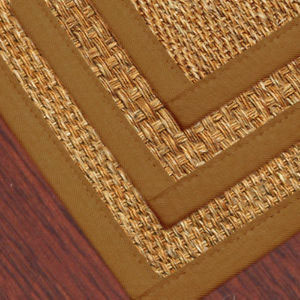WOVEN NATURAL FIBER RUGS are a favorite of ours at English Traditions. They are easy to maintain, eco-friendly, affordable and their natural look makes them versatile and perfect for any room of the house. Whether you are looking for an area rug or wall-to-wall coverage, like we have in our store, there is an abundance of options.
There are, however, a couple of things that you should know about each material so that you can find the perfect rug for your space. Here’s a little “Woven Natural Fiber Rug: 101” on some of the most common choices available.
JUTE

Jute is the softest of all the natural fibers, which makes it great for the feet, but it also makes it the least durable. This is an ideal choice for low to medium traffic areas, like bedrooms, but should be avoided in entryways, hallways or other areas that get a lot of traffic.
It’s made from the stalk of the plant, instead of the leaves, and is soaked for nearly a month (part of what makes it so soft). The stalks are then peeled and spun into a yarn that can have the appearance of wool. Jute, grown primarily in India, is the same material used in burlap. What do you need to know about maintenance? Avoid steam-cleaning jute, but vacuuming and spot cleaning are perfectly fine. With all natural fiber rugs, use a high-suction vacuum cleaner and be sure not to engage the brush, as this could tear the fibers of your rug, particularly jute
It’s made from the stalk of the plant, instead of the leaves, and is soaked for nearly a month (part of what makes it so soft). The stalks are then peeled and spun into a yarn that can have the appearance of wool. Jute, grown primarily in India, is the same material used in burlap. What do you need to know about maintenance? Avoid steam-cleaning jute, but vacuuming and spot cleaning are perfectly fine. With all natural fiber rugs, use a high-suction vacuum cleaner and be sure not to engage the brush, as this could tear the fibers of your rug, particularly jute
SISAL
Sisal is the most durable of the natural fiber options and is perfect for all of those high traffic areas. Of course, with the every pro there is a con. With the benefit of being so durable, sisal has the tendency to feel a bit prickly to the touch, so probably not fitting for a child’s bedroom. Although this material is ideal for entrances and other heavily trafficked areas, sisal should be avoided on stairs due to its ability to develop a slippery texture after it has experienced some wear.
What are some other advantages and disadvantages? Sisal is a very absorbent fiber. The pros are that it’s absorbency makes it dyeable, which gives you a variety of options to chose from. Also, its retentive nature will take in the humidity making your hot, sticky room cooler and more comfortable, but this also makes sisal more prone to stains (a definite con). In fact, should a stain occur, sisal is very difficult to clean because even the water used in cleaning the blemish may leave a spot.
Grown mostly in Mexico, Brazil and East Africa, sisal comes from the agave plant, which gives it the added benefit of being flame retardant (a definite pro). Like jute, sisal should not be steam cleaned; frequent vacuuming is recommended.
What are some other advantages and disadvantages? Sisal is a very absorbent fiber. The pros are that it’s absorbency makes it dyeable, which gives you a variety of options to chose from. Also, its retentive nature will take in the humidity making your hot, sticky room cooler and more comfortable, but this also makes sisal more prone to stains (a definite con). In fact, should a stain occur, sisal is very difficult to clean because even the water used in cleaning the blemish may leave a spot.
Grown mostly in Mexico, Brazil and East Africa, sisal comes from the agave plant, which gives it the added benefit of being flame retardant (a definite pro). Like jute, sisal should not be steam cleaned; frequent vacuuming is recommended.
SEAGRASS
Seagrass, as you would imagine, is grown in saltwater marshes. Naturally, seagrass is durable and water resistant because it is nonporous. Because of this, it is very stain resistant and great for those high traffic areas like living rooms and dining areas. Should you spill on a seagrass rug, it can easily be cleaned with water and leave no trace. Also, it is a friend to the foot with its smooth texture. However, if you’re installing seagrass in a staircase, make sure that you have the grains running parallel with the tread to avoid slipping.
So what are the downfalls? Since it is so moisture resistant, seagrass is not easily dyed and overtime seagrass will change color from a green to khaki. Also, since it doesn’t absorb, it can be susceptible to mildew or mold in areas that have an abundance or moisture, like a bathroom, unless precautions are taken handle excess humidity.
Seagrass is high on texture and is a nice complement to most furnishing, but usually needs a latex backing to protect the below flooring. Unlike jute and sisal, a seagrass rug is not reversible due to the backing, but this also will help with holding it in place. Maintaining a seagrass rug is as easy as running the vacuum, but like all natural fiber rugs, is not recommended for the outdoors.
So what are the downfalls? Since it is so moisture resistant, seagrass is not easily dyed and overtime seagrass will change color from a green to khaki. Also, since it doesn’t absorb, it can be susceptible to mildew or mold in areas that have an abundance or moisture, like a bathroom, unless precautions are taken handle excess humidity.
Seagrass is high on texture and is a nice complement to most furnishing, but usually needs a latex backing to protect the below flooring. Unlike jute and sisal, a seagrass rug is not reversible due to the backing, but this also will help with holding it in place. Maintaining a seagrass rug is as easy as running the vacuum, but like all natural fiber rugs, is not recommended for the outdoors.
MOUNTAINGRASS
Mountaingrass, also referred to as “hemp,” is very similar to seagrass in almost every regard. The two differences, other than where they are grown, are texture and color.
Mountaingrass, is not quite as smooth as seagrass, so may be slightly less “foot friendly,” however is still offers all of the stain resistant benefits that seagrass does. The most noticeable difference between the two is that mountaingrass has earthier tones, being more copper-brown than green-khaki. Both seagrass and mountaingrass are typically backed and will frequently have a canvas or leather binding.
Mountaingrass, is not quite as smooth as seagrass, so may be slightly less “foot friendly,” however is still offers all of the stain resistant benefits that seagrass does. The most noticeable difference between the two is that mountaingrass has earthier tones, being more copper-brown than green-khaki. Both seagrass and mountaingrass are typically backed and will frequently have a canvas or leather binding.
COIR
Coir is the perfect material for a front-entry. Made from the husk of coconuts, this material is course, stiff and durable. It dries quickly and is resistant to bacterial and fungal growth. Ideal for wiping off dirty shoes and cleaning off damaging salt during the winter months, this rug (although not soft on your bare feet) will help keep the rest of your home preserved, just make sure that you use a rug pad to protect the floor it’s sitting on top of. Like sisal, coir is susceptible to stains and should not be used on stairs due to the loose weave of the fibers. Although typically seen as shown above, it can also be woven into more sophisticated patterns like a diamond or herringbone.
Beautiful standing alone or used wall-to-wall with a more ornate, decorative rug over top, the possibilities are endless. Whether you are looking for the softness of jute, the stain resistance of seagrass and mountaingrass or the durability of sisal, with all of the varieties to choose from, there is definitely the perfect match for you. Stop by English Traditions to see all of the different colors, patterns and textures that are available.
Beautiful standing alone or used wall-to-wall with a more ornate, decorative rug over top, the possibilities are endless. Whether you are looking for the softness of jute, the stain resistance of seagrass and mountaingrass or the durability of sisal, with all of the varieties to choose from, there is definitely the perfect match for you. Stop by English Traditions to see all of the different colors, patterns and textures that are available.





Leave a comment